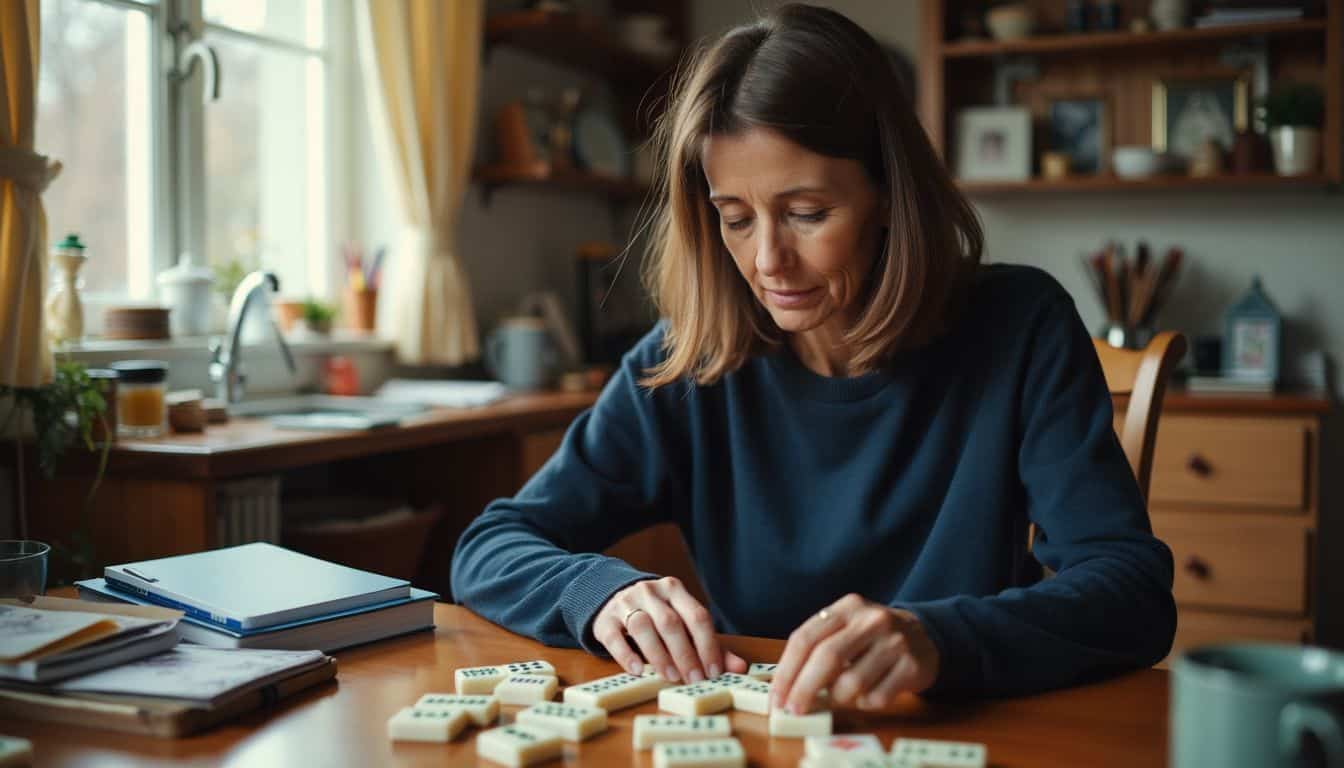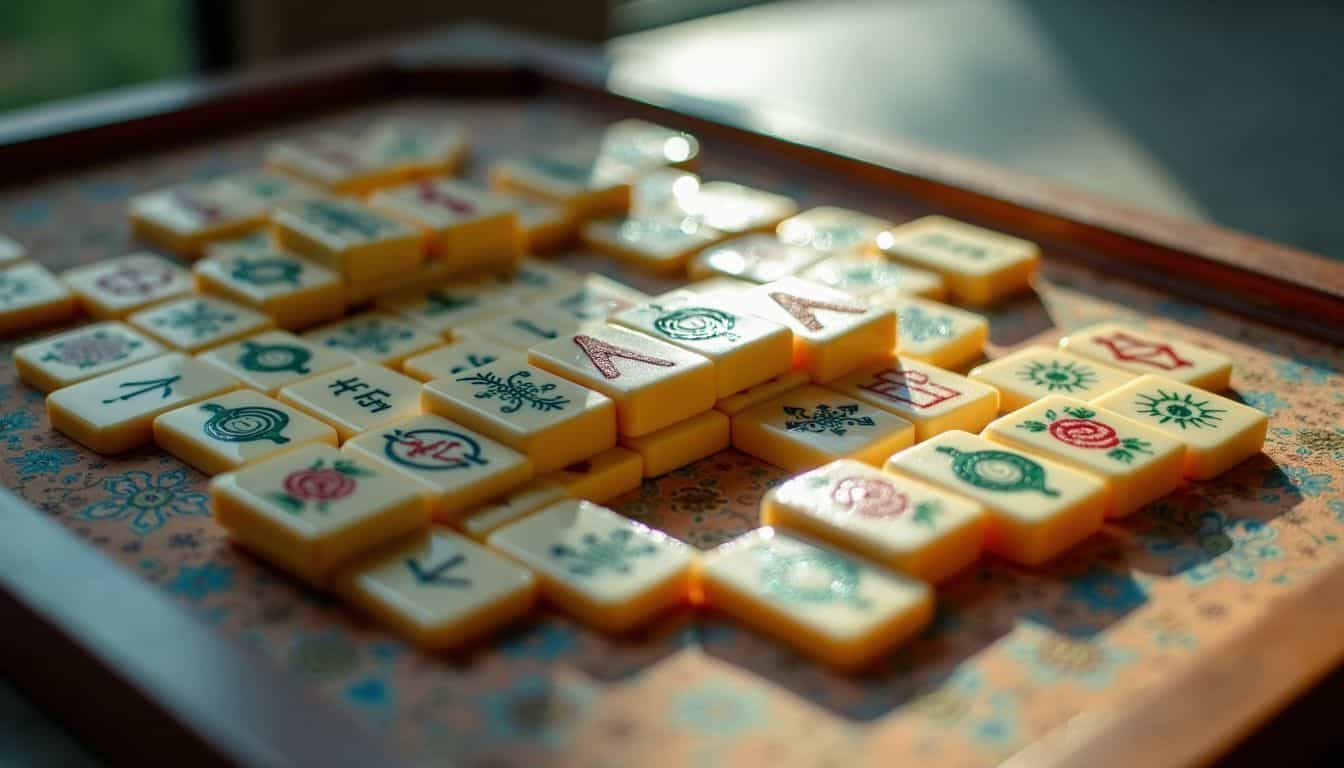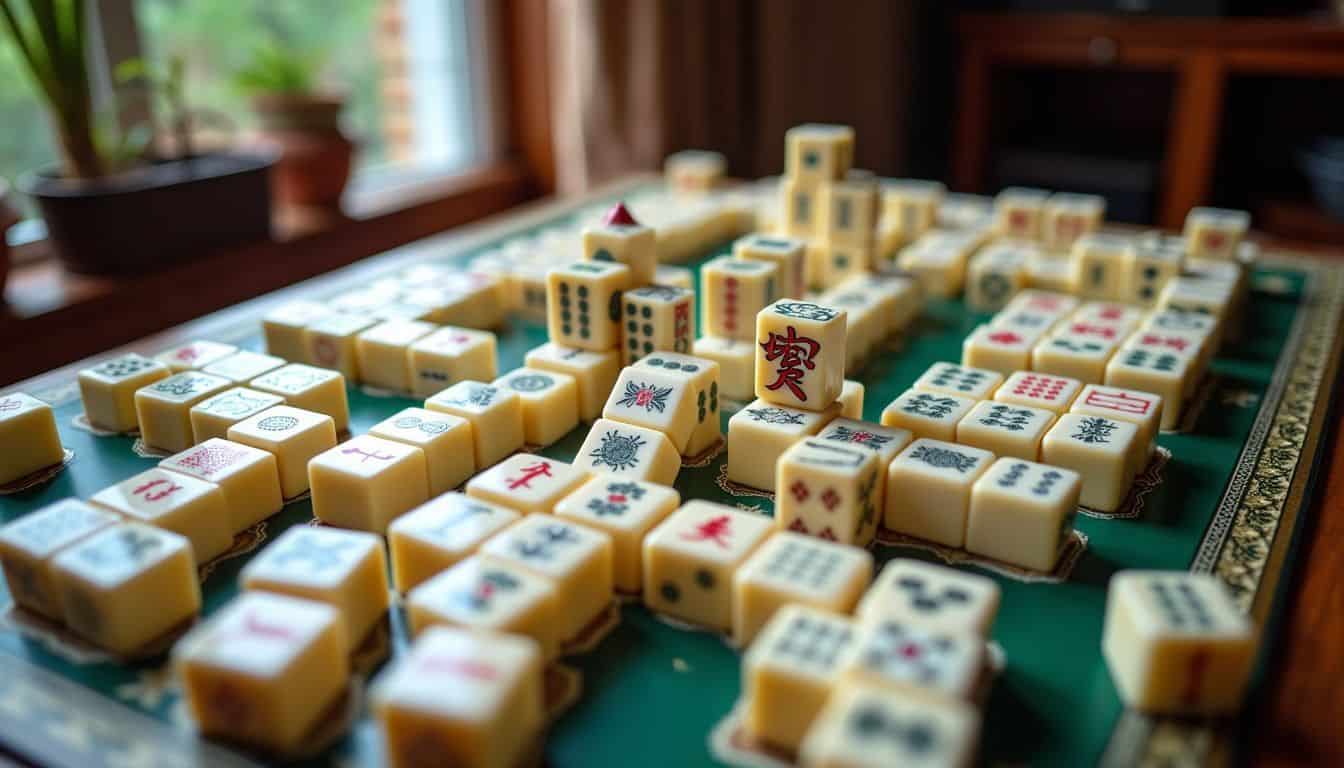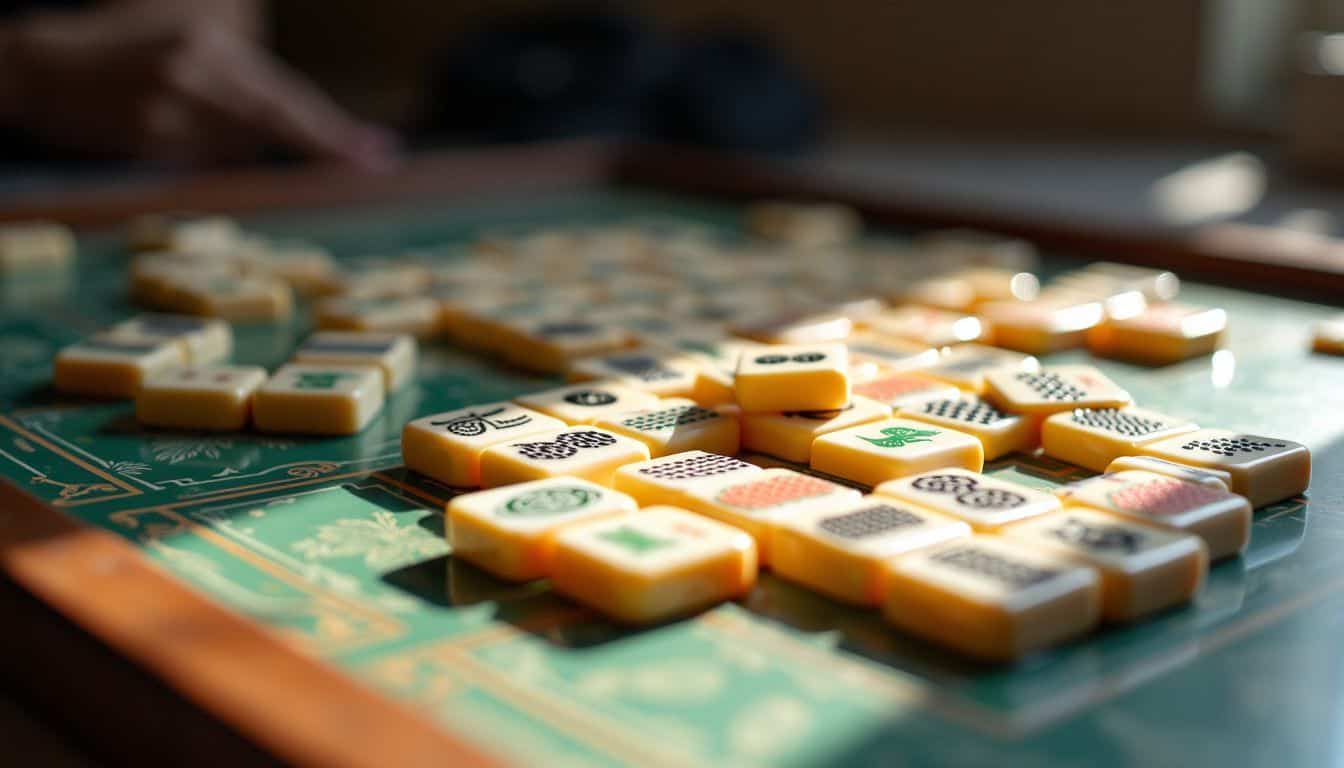Feeling stumped by the intricate world of Mahjong Solitaire? You’re not alone. This tile-based game has captivated players for decades with its mix of strategy and luck. This tile-based game has captivated players for decades with its mix of strategy and luck. Our guide will equip you with five awesome tips to dominate your next Mahjong Solitaire match.
Ready to become a tile-matching master?
Key Takeaways
Mahjong Solitaire uses 144 tiles stacked in a spider-like formation with three layers. Players clear the board by matching identical open tiles.
Focus on clearing high stacks and extended rows early to open up more options. Use the undo button wisely to reshuffle tricky tile arrangements.
Online versions offer 43+ layout options and computer-generated puzzles that are always solvable, unlike physical setups.
Tiles have different point values: Wan (2 points), Circle (4 points), Bamboo (6 points), Wind (8 points), Dragon (10 points), Flower (12 points), and Season (14 points).
To overcome stalemates, use the undo button, reshuffle tiles, check for hidden matches, focus on high stacks, and think several moves ahead.
Table of Contents
Overview of Mahjong Solitaire

Mahjong Solitaire isn’t your grandma’s card game. It’s a digital spin on the classic Chinese tile-matching fun. Imagine 144 tiles stacked in a spider-like formation, three layers deep.
Your goal? Clear the board by pairing identical tiles. But here’s the catch – you can only grab ‘open’ tiles. Those tricky blocked ones? They’re off-limits until you free them up.
Mahjong Solitaire: Where patience meets strategy, and tiles meet their match.
This game’s got more names than a secret agent. Shanghai Solitaire, ring a bell? It popped up in the 1980s, giving solo players a taste of Mahjong’s tile-tastic action. With a whopping 239,460 views, it’s clear this digital puzzler has won over fans everywhere.
Don’t let its simple premise fool you – Mahjong Solitaire is a brain-teaser that’ll keep you clicking for hours.
Preparing to Play Mahjong Solitaire

Ready to dive into Mahjong Solitaire? Let’s get you set up for a tile-tastic adventure. Here’s how to prep for your game:
- Pick your tiles: Go for classic Mahjong tiles, or spice it up with a Western card deck.
- Set the stage: Arrange 144 blocks in a spider-like shape. This layout’s got four layers and some cool jutting arms.
- Find a template: Newbies can grab setup guides online. They’re super helpful for nailing that perfect formation.
- Mix it up: Shuffle those tiles like a pro DJ. It keeps the game fresh and fun each time.
- Check your set: Make sure each block shows up four times. It’s key for fair play.
- Get comfy: Find a quiet spot where you can focus. This game needs your full attention.
- Set a timer: If you’re aiming for high scores, timing matters. Keep a clock handy.
- Clear some space: You’ll need room to move tiles around. A big table works great.
- Grab a buddy: While it’s solo play, having a friend nearby can make it more fun. They might spot moves you miss!
- Start simple: Begin with easier layouts. As you level up, try crafting your own crazy formations.
Essential Rules of Mahjong Solitaire

Mahjong Solitaire has a few key rules you gotta know… but don’t worry, they’re not rocket science! Ready to dive in and learn the ropes? Let’s go!
Match Tiles in Pairs

Matching tiles in pairs is the heart of Mahjong Solitaire. You’ll need eagle eyes to spot identical tiles on the board. Look for tiles with the same suit and number. But here’s a fun twist – ‘seasons’ and ‘flowers’ tiles are wild cards.
You can pair these up freely, no matter what they show.
Keep in mind, not all tiles are fair game. Only exposed tiles can be matched. A tile is exposed if it’s free on its left, right, and top sides. No other blocks should touch these spots.
As you clear pairs, more tiles become exposed. It’s like peeling an onion… but way more fun! Keep at it until you’ve cleared the board or run out of moves.
Identify ‘Open’ versus ‘Blocked’ Tiles

Now that you’ve got the hang of matching tiles, let’s chat about telling ‘open’ and ‘blocked’ tiles apart. This skill is key for doing well in mahjong solitaire. ‘Open’ tiles are your go-to in this game.
You can actually use them – no other tiles are on top, and at least one side is clear. ‘Blocked’ tiles? They’re off-limits until you make way.
In mahjong solitaire, freedom is just another word for ‘open’ tiles.
Think of ‘open’ tiles as the VIPs at your mahjong party. They’re ready to mix and match. ‘Blocked’ tiles are like shy guests – they’re stuck until you clear some space. Look out for tiles that can slide out without hitting others.
These are your tickets to winning. Clearing top layers first is important. It’s like peeling an onion – each layer you take off gives you more ways to play.
Tactics for Winning at Mahjong Solitaire

Ready to crush your next Mahjong Solitaire game? Let’s dive into some winning tactics… Trust me, you’ll want to stick around for these tile-tastic tips!
Focus on High Stacks and Extended Rows

Tackling high stacks and long rows is key to Mahjong Solitaire success. These areas often hold the trickiest tiles, so let’s dive into some smart moves:
- Start at the top: Clear upper tiles first. This opens up more options below.
- Target long rows: Knock out extended rows early. They can block crucial matches later.
- Break up clusters: Spot tile groups and split them up. This prevents dead-ends.
- Use exposed edges: Focus on tiles with open sides. They’re easier to match and remove.
- Plan ahead: Look for potential pairs a few moves down the line. This keeps your game flowing.
- Balance your approach: Don’t ignore lower stacks while working on high ones. Mix it up to keep all areas manageable.
- Watch for special tiles: Some layouts have unique pieces. Clearing these can open up big sections of the board.
- Stay flexible: If you’re stuck on a high stack, shift to another area. Come back with fresh eyes later.
Now that we’ve covered high stacks and rows, let’s look at planning your moves early in the game.
Plan Your Moves Early
 Planning ahead is key to winning at Mahjong Solitaire. Here are some smart strategies for early-game moves that’ll help you succeed.
Planning ahead is key to winning at Mahjong Solitaire. Here are some smart strategies for early-game moves that’ll help you succeed.
- Check the board: Look at all the tiles before you start. This helps you find potential matches and plan your first few moves.
- Begin with high stacks: Focus on removing tiles from the tallest piles first. It gives you more options as you play.
- Clear blocked tiles: Find matches that’ll uncover tiles trapped beneath others. This creates more possibilities for future moves.
- Keep easy pairs: Don’t hurry to match obvious pairs right away. Save them as a backup for when you’re stuck later in the game.
- Make a mental note: Try to remember where you’ve seen matching tiles. It’ll save time and help you plan several moves ahead.
- Focus on corner tiles: Taking tiles from corners often frees up more tiles. It’s a clever way to increase your options early on.
- Use a balanced approach: Don’t concentrate only on one area of the board. Spread your moves around to keep the whole layout flexible.
- Use undo carefully: If you make a move and think it wasn’t great, feel free to undo it. But use this option sparingly – it’s not a cure-all!
Wisely Use the Undo Option

Moving from planning to action, let’s talk about a game-changer – the undo option. This handy feature is your secret weapon in Mahjong Solitaire. Stuck? No worries! Hit that undo button and reshuffle those tricky tiles.
It’s like a do-over in digital form. But don’t go overboard with it! Use it wisely, folks. Keep those tiles in play and increase your chances of winning.
Online Mahjong often includes this undo magic. It’s a lifesaver when you’re in a tight spot. Some setups might seem impossible, but a quick reshuffle can open new possibilities. Keep in mind, strategy is key.
Use your undos smartly, and you’ll be racking up points in no time. It’s all about keeping those tiles flowing and your game going strong.
Experience Mahjong Solitaire Online

Ready to take your Mahjong Solitaire game online? Tons of platforms offer this classic puzzle game with a digital twist. You’ll find new challenges and perks that aren’t in the tabletop version – it’s a whole new ball game!
Selecting the Best Platform
Picking the right platform for Mahjong Solitaire can make or break your gaming fun. Look for sites with cool graphics and easy-to-use controls. A Clockwork Brain is a great choice for classic games like this.
It’s free and offers a smooth play experience. Plus, it’s got lots of layouts and tile designs to keep things fresh.
Good platforms give you helpful tools, too. Hints can save you when you’re stuck. Undo buttons let you fix mistakes. And regular updates? They keep the game exciting with new challenges.
I once spent hours on a site that hadn’t been updated in years – big mistake! Now, I always check for recent changes before I start playing. It’s the little things that make Mahjong Solitaire a blast to play online.
Variations from Tabletop Mahjong Solitaire
After picking the best platform, let’s explore how online Mahjong Solitaire differs from its tabletop cousin. Digital versions offer a wealth of layout options – a whopping 43 on Solitaire Bliss alone! That’s way more than you’d get with physical tiles.
Plus, these computer-generated puzzles are always solvable, unlike real-life setups that might leave you stuck.
Online play is a godsend for newbies. Pre-made layouts and hint features make learning a breeze. No need to fuss with shuffling tiles or setting up the board. Just click and play! The game’s core remains the same, but these digital tweaks make it more accessible and fun for geeks of all levels.
Scoring System in Mahjong Solitaire

Scoring in Mahjong Solitaire isn’t just about matching tiles. It’s a mix of speed, strategy, and luck – kinda like a game of Rummy on steroids! You’ll rack up points for each pair you clear, but watch out… the clock’s ticking, and those bonus points won’t wait forever.
Understanding the Points Allocation
Points in Mahjong Solitaire aren’t just random numbers. Each tile type has its own value. Wan tiles, showing Chinese characters, give you 2 points. Circle tiles bump that up to 4 points.
Bamboo tiles, including the bird, are worth 6 points each. Wind tiles blow in 8 points, while dragons breathe fire with 10 points. Flowers bloom at 12 points, and seasons top the chart at 14 points.
Knowing these values can shape your strategy. You might aim for high-scoring tiles first. Or, you could clear low-point tiles to open up the board. It’s like a puzzle where each piece has its own weight.
The more you play, the better you’ll get at balancing point values with board clearance. It’s part of what makes this game so addictive for us geeks!
Bonus Points and Timing Considerations
Bonus points in Mahjong Solitaire can make or break your game. Clear the board completely, and you’ll rack up extra points like a pro. But don’t dawdle! Time matters too. The clock’s ticking, so focus on those top layers first.
It’s like peeling an onion – start from the outside and work your way in.
Want to crush the competition? Plan your moves ahead. It’s chess, not checkers! Keep an eye on high-value blocks to max out your score. And hey, why not use a stopwatch? Track your time and see how you stack up.
Trust me, I’ve spent countless hours honing these tricks. They’re game-changers!
Addressing Common Obstacles in Mahjong Solitaire

Stuck in a Mahjong Solitaire jam? No sweat! We’ve got some nifty tricks up our sleeve to help you out of those tricky spots. From dealing with dead-ends to making the most of limited moves, we’ll show you how to keep the tiles flowing.
Resolving Stalemate Conditions
Stalemates in Mahjong Solitaire can be frustrating. But don’t worry – we’ve got some tricks to help you overcome those tricky situations.
- Undo button: Your go-to solution when you’re stuck. Use it to backtrack and find moves that create more opportunities.
- Reshuffle tiles: If you’re completely stuck, many digital versions allow you to mix up the remaining tiles. This can create new matches and get you back on track.
- Check for hidden matches: Sometimes, tiles that appear blocked might actually be free. Take a close look at each layer.
- Focus on high stacks: Clearing tall piles first can reveal more tiles underneath, giving you more matching options.
- Think ahead: Consider two or three moves in advance. This approach helps avoid dead ends and keeps the game moving.
- Use power-ups smartly: Some versions offer power-ups like hints or extra shuffles. Save these for when you really need them.
- Take a break: A fresh perspective can help you spot matches you missed before. Step away and come back with renewed focus.
- Learn from losses: If you don’t succeed, try the same layout again. You’ll likely notice better moves the second time around.
Mahjong Solitaire can be addictive, and you might find yourself wanting to play for many hours. Just keep in mind, practice improves your skills. Now, let’s look at how scoring works in this tile-matching game.
Handling Limited Moves Effectively
Limited moves in Mahjong Solitaire can stump even seasoned players. Let’s dive into some nifty tricks to keep your game going when options seem scarce.
- Scan the board carefully: Don’t rush! Take a good look at all tiles, especially those hidden in corners or under other pieces.
- Focus on freeing blocked tiles: Clear tiles that are holding others hostage. This opens up more matching options.
- Use the undo button wisely: Made a move you regret? Hit that undo! It’s not cheating, it’s strategic thinking.
- Prioritize high stacks: Tackle tall piles first. This creates more space and reveals hidden gems beneath.
- Look for chain reactions: Sometimes, one smart move can trigger a series of matches. Keep an eye out for these domino effects.
- Reshuffle as a last resort: If you’re truly stuck, most digital versions offer a reshuffle option. Use it sparingly!
- Plan ahead: Think two or three moves ahead. This foresight can help you avoid dead ends.
- Be patient: Don’t panic if moves seem limited. Take a breather, reassess the board, and you might spot something new.
People Also Ask
What’s the difference between Mahjongg Solitaire and multi-player Mahjong?
Mahjongg Solitaire is a single-player game where you match tiles. Multi-player Mahjong involves several people and different rules. Solitaire Mahjong was first popular on computers like the Atari ST and Commodore. It’s a great way to kill time alone!
How can I learn to play Mahjongg Solitaire?
You’ve got options! Check out YouTube channels for visual guides. WikiHow has step-by-step instructions. Or, dive into a Mahjong game on your device and learn as you go. Practice makes perfect, so keep at it!
Is Shisen-Sho similar to Mahjongg Solitaire?
You bet! Shisen-Sho is like Mahjongg Solitaire’s cousin. Both use similar tiles, but Shisen-Sho has a twist. You can only match tiles with a clear path between them. It’s a brain-teaser that’ll keep you on your toes!
Where can I find answers to frequently asked questions about Mahjongg Solitaire?
Many Mahjong game apps have FAQ sections. Online forums are goldmines for player tips and tricks. Don’t forget to check out dedicated Mahjong websites. They often have extensive FAQ pages to help you out of any tile trouble!
